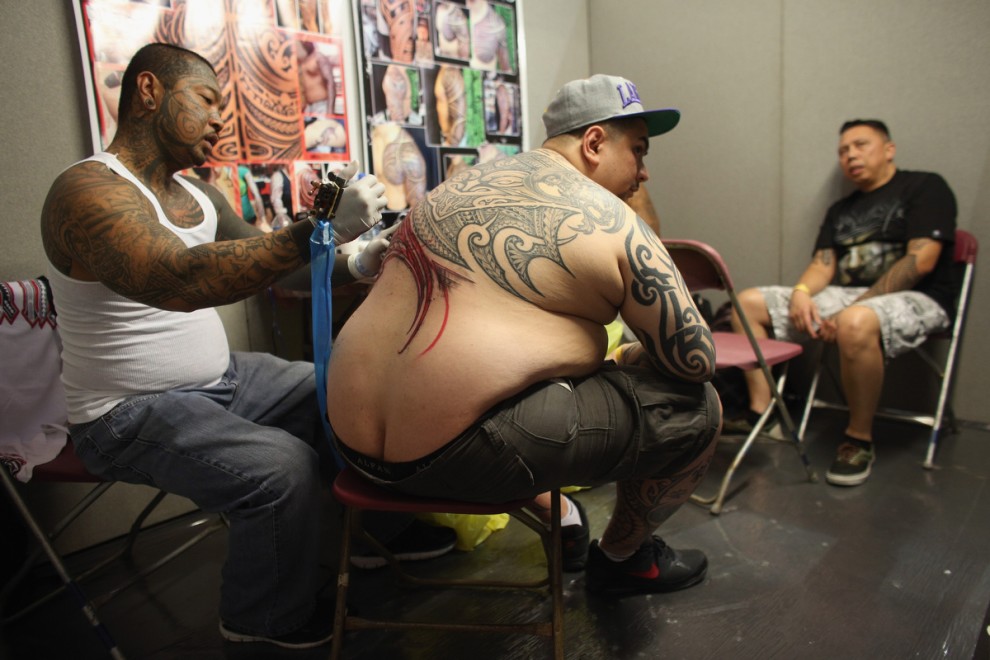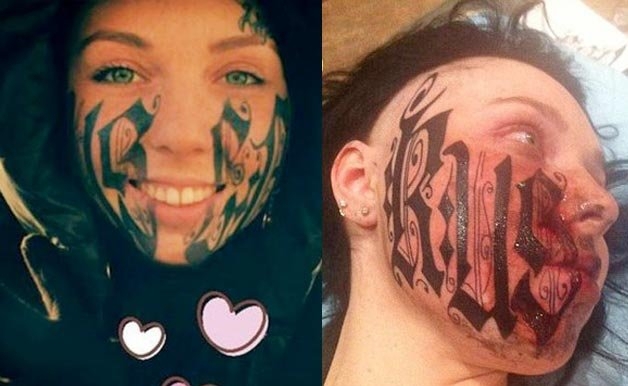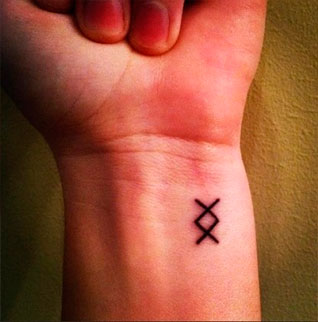- Москва, ул.Лётчика Грицевца 14а,
м. «Пыхтино» - Ежедневно, с 1200 до 2000
- +7 (915) 000-77-99 - (Телефон салона) +7 (915) 000−77−99 - (WhatsApp)+7 (915) 000−77−99 - (Viber)
- domtattoo@yandex.ru
RISK, REGRET, AND THE TATTOO CONSUMER
Все о татуировках
- Стили татуировки
- Белая татуировка
- Биомеханика (Biomechanics) и Органика
- Блэкворк ( Blackwork)
- Дотворк (Dotwork)
- Готика «Gothic»
- Кельтские
- Клокворк
- Нью Скул ( New School)
- Олд Скул ( Old School)
- Ориентал (Oriental)
- Полинезия
- Реализм
- Стимпанк
- Сюрреализм (Сверхреализм)
- Трайбл (Tribal)
- Треш полька
- Черно-серая "Black&grey"
- Чикано (Chicano)
- Этнический стиль тату (Ethnic)
- Японские тату
- Тотемные тату Тлинкитов
- Татуировки- надписи
- Временная татуировка.
- Хоррор
- Парные тату
- Крестиком
- Кружева
- Ультрафиолетовая татуировка
- Татуировки на частях тела
- Надписи для тату с переводом
- Надписи с переводом с немецкого на русский язык
- Надписи, афоризмы, цитаты на португальском и бразильском языке с переводом на русский
- Надписи на испанском с переводом
- Перевод фраз и гимнов (стихов) с хинди на русский
- Фразы, надписи и афоризмы на арабском языке с переводом
- Надписи для мужчин
- Надписи для мужчин с переводом
- Благородный муж
- Друзья и дружба - мысли великих.
- Труды, достижения и ошибки - надписи для тату
- Враги и недруги, война и кровь в надписях для мужчин
- Надписи о Смелости и Силе для мужских тату с переводом
- 120 надписей для Мужчин о Смелости, Силе и Движении Вперед
- Тату надписи для Мужчин-воинов и защитников Отечества на тему Смелости, Чести, Мужества, Долга и Действия
- Надписи для девушек
- Надписи на тему: Любви, Семьи и Верности с переводом на Английский
- Надписи с переводом о семье на разные азыки мира.
- Вопросы о татуировках
- Астрология и астральная геометрия
- Значение тату
- Уход за татуировкой
- Для СМИ и видео проектов
- Татуировка на шрамах
- Иглы и краски для татуировок
- Зодиакальные татуировки...
- Стили, виды татуировки. Сведение тату.
- English language
- Все о Сак Янт - Тайской Шаманской Татуировки
- Священные татуировки - ИЗ ПРОШЛОГО
- МАГИЧЕСКИЕ ЧЕРНИЛА: ЗАКЛИНАНИЯ И СИГИЛЫ
- ИГЛОЙ НА КОЖЕ
- ЛУК СИТ
- КХРУ САК
- ВИЧА
- ТЕКСТЫ И ЧИСЛА, ТЕЛЕСНЫЙ ЩИТ
- ЯНТРЫ ЧОК ЛАП ПРИНОСЯТ УДАЧУ И ПРОЦВЕТАНИЕ.
- ТРАНС
- ТРАДИЦИИ САК ЯНТ В ТАИЛАНДЕ
- ЗАКЛИНАНИЯ И ПИСЬМЕНА
- Обучение мастеров-татуировки в Тайланде (ТРАНСФОРМАЦИЯ И ДИСЦИПЛИНА)
- Сигилизм
Информация
- Портфолио
- Все о пирсинге
- Виды и стили
- Подготовка и процедура пирсинга
- Когда пирсинг уже сделан
- Бод Мод
- Украшение для пирсинга
- Инструмент для пирсинга
- Словарь терминов
- Cтоимость пирсинга
- Магическое, символическое значение пирсинга
- Вопросы и ответы про пирсинг
- Удаление татуировок
- Все о татуаже
- Новости
- Ответы на часто задаваемые вопросы о тату.
- Работы тату художника Yann Travaille
- Съемки MTV
- Проба пера
- Съемки Дискавери в судии ...
- Энциклопедия пирсинга
- 7 Московская Международная Тату Конвенция
- «Звёздный» гость салона «Дом Элит Тату» - известный продюсер Андрей Клюкин
- Ушел из жизни тату мастер Илья Смирнов
- Мы примим участие в Питерской тату конвенции 2015 года
- У нас делают татуировки модели Creepy Sweets
- Оригинальный майки и футболки с аэрографией за 4.000 рублей
- Мы получили независимую премию "Лучший Тату Салон 2015 года" по версии портала Татуировка.Рф
- Мы участники и победители тату конвенции в Москве
- Мы организаторы "Ночи Татуировщика 2015 в Москве"
- Rock heroes: Miss Тату Хабаровск
- Немецкий политик сядет в тюрьму за то что сделал нацистскую татуировку
- Международная Московская Тату Конвенция 2016
- Санкт-Петербургский Тату-Фестиваль
- 2 Международный фестиваль татуировки Сочи 2016
- Самый старый татуированный человек на нашей планете.
- 9-я Международная Московская Тату Конвенция 2017
- Тату мастер с 1.4 миллионом подписчиков маскирует растяжки
- Miss Tattoo Australia Дженн Десмонд - водитель грузовика
- Тату разрешены
- Зейн Малик сделал татуировку с глазами Джиджи Хадид на груди
- Тату как запрет на реанимацию
- В честь ЛДПР прошла тату-вечеринка
- Тату салон в Самаре
- Аренда места в тату салоне Москва. Как правильно и главное где арендава
- Обучение и все о нем
As we have seen, the person entering the tattoo setting commonly experiences considerable anxiety, especially since he or she typically has little or no prior experience with tattooing. The novice client possesses, at best, minimal knowledge of what the tattooing process entails. Due to the limited number of tattoo studios available in most areas, the potential client generally has little opportunity to compare prices and quality of work. However, the tattooee is usually intensely aware that the tattoo is a permanent addition to the body and that the application process involves some degree of pain. When asked to describe their state of mind when entering the tattoo establishment to receive their first tattoo, interviewees typically spoke of feeling nervous and fearful. Anticipation of «physiological risk» involving significant pain was the major source of their anxiety.
As indicated by this respondent, information provided by one's everyday
associates usually increases the novice tattooee's anxiety rather than reducing
it. The most effective means by which recipients eased their  nervousness were talking with the tattooist and watching while
other clients were serviced.
nervousness were talking with the tattooist and watching while
other clients were serviced.
Tattooing also entails the violation of significant norms governing the interaction between strangers. There are few settings in everyday life in which extensive physical contact, the willful infliction of pain, and exposure of intimate parts of the body to virtual strangers are routine aspects of commercial interactions. Since the tattoo studio is largely a male domain and most tattooists are men, body exposure and intimate touch were factors of physiological risk about which women tattooees expressed concern with conSiderable regularity.
The nebulous and largely incorrect information about tattooing that
circulates within conventional social networks contains cautions about
Even when he or she chooses a small design, the tattoo client, armed with
minimal
 When confronted with the «sticker shock» generated by
the prices posted on the flash lor, in the case of those requesting custom
work. hearing about the estimated length of time the tattoo will take and the
artist's hourly rate). inexperienced tattooees usually either swallow hard and
pay the money up front or they reduce their risk by revising their expectations
and picking a smaller and less expensive design. It is interesting that tattoo
selection on the basis
When confronted with the «sticker shock» generated by
the prices posted on the flash lor, in the case of those requesting custom
work. hearing about the estimated length of time the tattoo will take and the
artist's hourly rate). inexperienced tattooees usually either swallow hard and
pay the money up front or they reduce their risk by revising their expectations
and picking a smaller and less expensive design. It is interesting that tattoo
selection on the basis
The tattoo process
Proprietors typically provide at least some minimal forms of diversion for
waiting customers. Most provide waiting areas in which the client can leaf
through 
Tattoo clients are also concerned with the «social risk» they run when they deCide to have their bodies indelibly marked. While, as we have seen, various subcultures positively value tattooing as a symbol of commitm~nt and belonging, the tattoo is still defined as a stigmatizing mark by most members of mainstream SOCiety. The consumer is aware of the potential negative social consequences of being tattooed. Employers, parents, and other representatives of «straight» society are justifiably seen as interpreting the tattoo as a symbol of the general deviance and untrustworthiness of the wearer. The major way in which the novice deals with the potential social risk of tattoo possession is by limiting his or her commitment. The first tattoo is usually small, relatively inexpensive, and placed on a body location which is easily hidden from strangers or casual associates. Choice of a small tattoo placed on a readily concealable body location acts to decrease the potential negative social consequences of tattoo possession. In addition, since the small design is inexpensive. financial risk is minimized and. because a small tattoo is qUickly applied. physiological risk is minimized as well.
Positive social responses from friends and other members of the novice
tattooee's reference group also help decrease feelings of social risk, As
described earlier. getting tattooed is a highly social experience for most
While a certain level of risk is characteristic of all service interactions. it is particularly intense in settings where marginal or deviant services (for example. illegal abortion. prostitution, tattOOing) are produced an.
As a type of marginal service interaction the purchase of a tattoo entails conSiderable risk. Lack of familiarity with the purchase setting. anticipation of pain. uncertainty about social consequences. unanticipated expense. and other unknown factors lead the client to experience a high degree of risk.
The tattoo consumer uses a variety of strategies to help reduce his or her experience of risk in the tattoo encounter. In particular. the tattooee uses information prOVided by characteristics of the setting and the interaction within it to ease feelings of anxiety. The cleanliness and order of the studio, the quality and variety of the flash, the appearance and demeanor of fellow customers, and photos of past work are important sources of information. The customer's interaction with the tattooist is of particular importance, since this is the primary source of the information he or she uses to calculate trust.
The literature on patient satisfaction with medical service clearly
shows that the client's evaluation of the service is, to a major extent, shaped
by his or her interactional experience with and relationship to the service
deliverer. The tattooee's experience of risk in the tattoo shop and
It is uncommon for tattooees to express dissatisfaction with being tattooed per se. Those that do tend to focus on the inferior craftsmanship of the service they receive. Concern with inferior quality is most commonly exhibited by more heavily tattooed people who have sufficient experience to evaluate the technical merits of their collection.
.jpg)





